On the trail of weirdness in the South of France
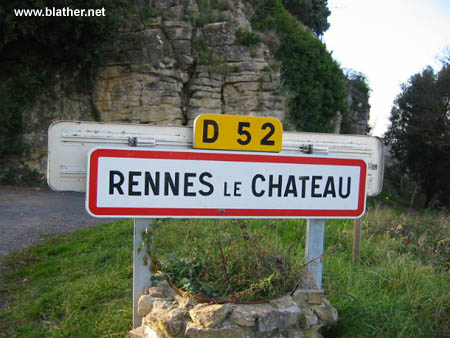
I arrived in Rennes-le-Chateau at around 4pm on December 21st 2002. The car thermometer was reading 18 degrees – some winter’s day!
While driving through the nearby village of Couiza, I could see R-l-C on a hill above. Mere minutues away, I thought. In fact, it was 4km and countless hairpin bends later. And a crazy old hippy, his Fiat Uno covered in stickers, who came barelling around a corner, nearly hit me, then honked like it was my fault annd waved his fist before barrelling on.
Rennes-le-Chateau just about fits on the top of a high, almost conicle hill, the slower slopes having ruined medieval keeps here an there. There’s not much to the village – The Sauniere church and museum appears to be the only source of economy here, other mercantile activies having being long won by nearby Couiza.
The bookshop was closed as I passed by, though a sign indicated that I should ring the bell to gain access. The window display showed a selection of books about the village’s mysterious priest, the cathars, the templars, and a smattering of pseudo-medieval tat.
The church, while less than imposing, is certainly bizarre. Unfortunately both it and the museum were closed for Christmas when I arrived this was the 21st, if I had a arrived a day earlier, I would have gained access. So, no devil statues for me. I did see the latin ‘this place is terrible’ inscription, the skull and crossbones carvings, the rather strange crucifix, the little open air prayer chapel, and a nice cat, who didnn’t appear to be involved in any heretical carry-on that I could see.
Most impressive though was Sauniere’s tower, with its commanding view of the Aude Valley and of the Pyrenees. Check out the photos….
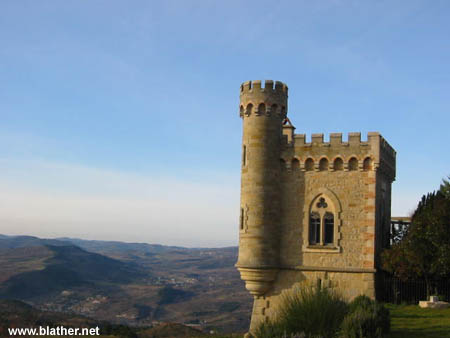
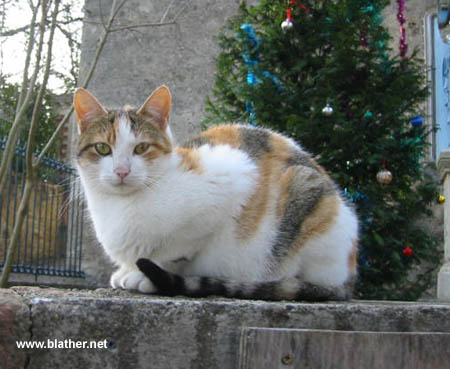
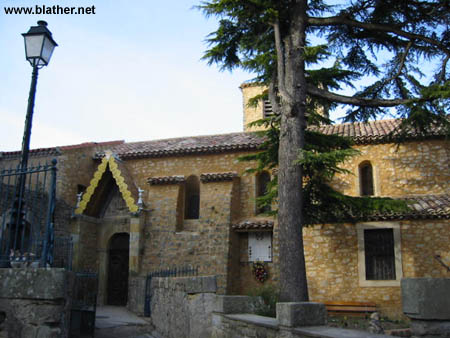
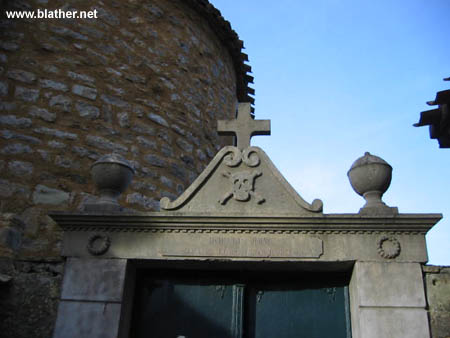
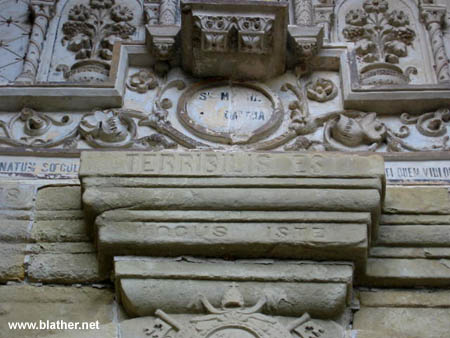
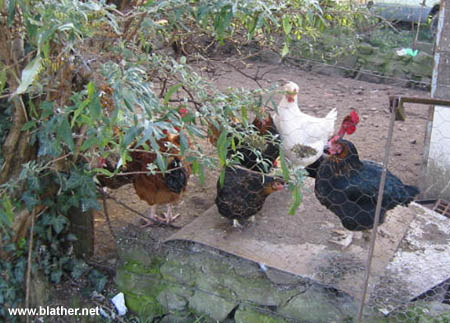
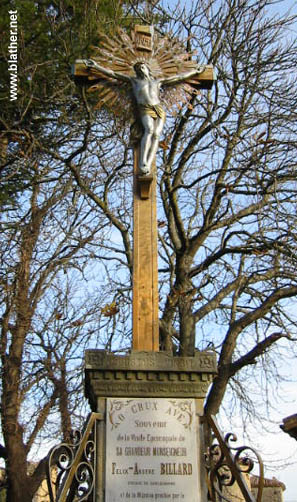
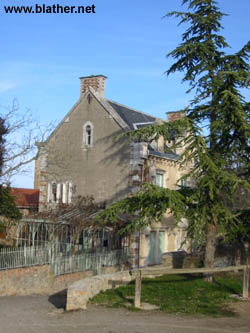

Download large image of the view
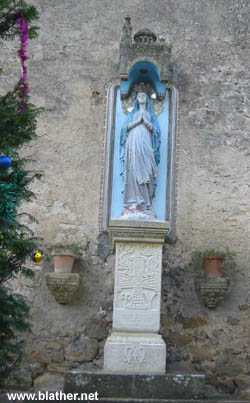
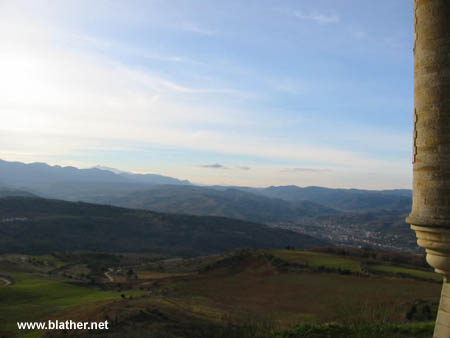

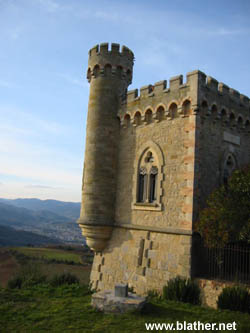

Just heard from my friend Doug Skinner:
Here’s a bit on Rennes-le-Chateau for you: I suspect that “Terribilis est locus iste” is less mystifying than people claim. It’s your basic Vulgate for Genesis 28:7, where Jacob has his funny dream. The plainchant on the text was used for consecrating churches; for example, Dufay quotes it in his “Nuper rosarum flores,” the ingenious architectural motet he composed for the dedication of the dome of the Florence cathedral.
That devil, of course, is a different story… Doug Skinner
I think you are right about Genesis 28 only was it not Joseph who had the dream? What about the very strange break in continuity around these chapers in Genesis? Jeremy
I love this mystery. I think all that we read is in code. I am working on it, kind of playing armchair detective.
Enjoy the game!
Bebe
I’ve been to R-L-C and while the inside of the church is cool the museum wasn’t all too informative as i remember, I was slighty dissapointed by the lack of obvious clues left about in a scobby doo fashion though so my recollection is a bit biased.
The computer game ‘Gabriel knight 4’ has a pretty accurate 3D reconstruction of Renne and even has that little shop you mentioned! only there are some tapestries in a hall that weren’t there in reality; but still amazingly researched for a fantasy computer game about a vampire hunter!
And a little warning about playing armchair detective with these codes, read ‘Faucalt’s pendulum’ by Umberto Eco – don’t get too carried away with secrets or they might make you disappear with them.
Secrets secrets secrets.
The square and the circle is the key.
No one is any nearer to unlocking these secrets, not even Dan brown.. if only they new
the 5 senses by david teniers the younger shows a painting within a painting. a pair of blue apples hangs above the heads of the diners. looking closer one sees they are a pair of blue skulls. look closer and the skulls turn into a pair of cave openings looking out on a blue sky.the same cave appears in st. anthony hermit. between the cave openings appears the cross of john the baptist pointing up to the treasure. poussin deppicts the baptist standing by the tomb in arcadia in a little known sketch. the mona lisa is an anagram for salomina or little salome. oscar wilde the freemason knew of this connection. the mandaeans who revered the baptist are gnostic dualists as were the cathars. jesus never existed. that connection is the disney fairy tale.there is much much more.
And so what of the Merovingian bloodline in the south of France?The coded parchment with which we are dealing clearly states “To Dagobert 2 king, and to Sion belongs this treasure…The king was the last direct descendant of the Merovingian bloodline in historical accounts.But once more the Baptist rather than Christ is the implicated progenitor.The ritual of baptism was not invented by John.It is Sumerian in origin.Ea or Oannes as instructor of the Philistines arose every day from the sea to teach his initiates.According to Joseph Campbell, Ea/Oannes had as his symbol the tenth sign of the Zodiac Capricorn, a composite beast with the foreparts of a goat and body of a fish. In the Hellenistic period Ea was called Oannes,which is in Greek Ioannes,Latin Johannes,Hebrew Yohannan, English..John.The Quinataur then as the equatic beast-founder of the Merovingians is the Baptist.And the half-goat half-fish was the symbol for Pan-Capricorn who could substitute his hooves for a fishtail.Pan was the god of Arcadia.Et In Arcadia Ego is the motto on poussin’s tomb.”I too am in Arcadia points to John, just as the kneeling shepherd points at the tomb and John in Poussin’s sketch points to heaven.According to Josephus Salome died in the south of France…
shane,
the parchment was a fake.
the parchment was not a fake. check out The triumph of pan,the lost treasure of the jerusalem temple,by Nicholas Poussin. Three heads surround a body. “Three Each and One Thing occurs on the Sauniere bookplate. My family is of Irish Merovingian origin. The home of the Grail. Jesus never existed.He was the spiritual twin of John the Baptist.It is the ultimate heresy.The 5 senses by Teniers confirms the signifigance of the number.The Quinotaur comes from ” Quin” or 5. The Rite of the Seven Veils was the Sacred Marriage of Ishtar to Tammuz.Tammuz means Thomas. The Gospel of Thomas speaks of a sexual relationship between Salome and Jesus.The twin. The lie.The ultimate heresy.
shane. the parchment was a fake. how do we know this? because the bloke who faked it, signed it, dated it and then went on the record stating that he had faked it.
see here: http://en.wikipedia.org/wiki/Philippe_de_Ch%C3%A9risey#Details_of_the_forgeries
Thank you for replying Damien.And thank you Daev for giving me space on your website.And of course Damien you are right to be sceptical.I am not here to convert anyone.Sauniere’s bookplate is no fake however.It is an alchemical motif from Heinrich Madathanus’ The Golden Age Restored.The Centrum In Trigono Centri is a reference to Pan.Aliester Crowley used it in his Rite to Jupiter.But before you dismiss the whole mystery as a hoax, you might try checking out the paintings themselves.”That Poussin/Teniers hold the key”is no lie. Apart from the beauty of poussin’s works,there is a recurring motif.3 heads surround a decapitated body in a parody of the shepherds at the Arcadian tomb,who lie dead in”The Sack of the Jerusalem Temple”.You might also check out “The Triumph of Pan”. “3 each and One Thing” and “The Three are Marvelous”from the bookplate refer to the 3 heads around 1 body.And 3 openings leading into a single cave.It is also the triple conversion from the alchemical primal matter.An 18th c.woodcut called”The Tomb of Jaques de Molay shows a decapitated body in a cave.Again,the 3 heads appear.In a monastery outside of Slane my great grandfather left documents.Slane was the retreat of Dagobert 2.The roots of Christianity are very dark.Oscar Wilde was destroyed by the secret as was Sauniere.Read the Gospel of Thomas and von Eschenbach’s “Parzival”.The Christ-story derives from Tammuz “The Good Shepherd of His People”.His consort was Mari-Ishtar as Virgin,Temple Whore and Mother.She wept at the tomb of Tammuz in the guise of 3 Mary’s.Adonis like Christ was born in a cave in Bethlehem and devoured as bread and wine.And Christ like Pan had 12 disciples [Pan’s Panes].In Wilde’s Salome the moon passes through 3 phases, red,black and white.It represents the triple alchemical conversion during the 7 veils rite.And far-fetched as it may sound,snow-white with her black hair,red cheecks,white skin and 7 dwarves is also allegorical.Walt Disney the Freemason was aware of this.The fairy tale is very ancient.Aubrey Beardsley’s frontispiece for Salome shows a hermaphrodite Pan with the”X” cross on his chest.It is a parody of Poussin’s “Triumph of Pan”.With regards to Tammuz/Thomas and “twins”,Eschenbach’s “Parzival’s” central theme is about twins, red and white/black and white.In the Old Testament red and white twins recur in a struggle for birthright.[See Zoroastrianism,Mandeism and Gnostic Dualism.]Jesus was a mystery school used by John’s following.Jesus,or Yehoshua simply means “Saviour”.Twins.Mirrors.Inversions.Dualism.”Terribilis est Locus Iste” describes the prison-world we were asigned to by Yahweh or “Old Nobodaddy”- the creator-god of the Cathars.In the Cave of the 5 Senses the Baptist’s cross reaches up between the Blue Apple cave openings.The same cave in Tenier’s St. Anthony Hermit and the same cave in which the Magdalene kneels before the Baptist’s cross on Sauniere’s alterpiece.
How refreshing to find an open discussion group on the village enigma. I believe the St. John manuscript was prepared by Sauniere – to replace something that Bigou left behind. Look at verse 5 – it is a quadratic equation in the making. Wonderful stuff. As for the treasure manuscript and the dead man, This is authentic and leads to a place outside the village – 6 miles outside the village. Now, for an interesting exercise, why not take a look at the first line of the inscription on the Negre headstone. Believe you me, it will be well worth the exercise. The place is the ruin of Alet Cathedral.
manuscripts genuine and they will lead to a place. The ruin of Alet Cathedral.
hi lionel.”Compare me to someone and tell me who i am like”. It is not an enigma. It is from The Gospel of Thomas and Mathew’s Gospel. The inevitable conclusion is made that Jesus is like John.But the location of the conversation is Caesaria Philipi,not alluded to in Thomas gospel.Caesaria philippi was the location of Pan shrines who was worshipped by Herod.At Ein Kerem near Jerusalem the source of the Jordan begins. It is also the cave of Pan the Baptist.In the Gospel of Thomas Salome says “Who are you Man. You have climbed upon my couch…” The sacred marriage of John and Salome was the reinactment of Tammuz and Ishtar in the Sacred Marriage.Only it becomes a rather unsavoury snuff movie which the Catholic church would rather leave out.According to Josephus, the Herods were banished to the south of France where Salome died.She gave birth to the Merovingian dynasty.She was called Magdala or “Great Lady”.Her name survived into the Christ/Magdala myth. At the council of Nicea the heretical texts of course were known and dismissed. It is a secret beneath a secret beneath a secret.In the Poussin paintings “Midas and Bacchus” and “The Shepherds of Arcadia”, Bacchus’ legs are crossed.The crossed legs of the Skull and Crossbones.The crossed legs of the Baptist cross.The crossed legs of the Skull and Crossbones Templars and the sea-faring sons of Merovee- the pirates. the Templars became pirates when they were forced to roam the seas after their destruction by Philip la Belle.There is much, much more
HI AGAIN LIONEL. I’M A BIT BEHIND.WHAT IS THE ST.JOHN MANUSCRIPT?VERSE 5 SOUNDS SIGNIFICANT.AND A QUADRATIC EQUATION COINCIDES WITH THE 4 CHERUBS[EARTH AIR FIRE WATER ]AND THE SAUNIERE BOOKPLATE, AND THE 4 ANGELS ABOVE THE HOLY WATER FONT.”BY THIS SIGN SHALL YE KNOW HIM”.ST.BERNARD DE COMMMINGES IN THE SOUTH OF FRANCE IS A CATHEDRAL ALIVE WITH IMAGES OF THE GREEN MAN AND SEVERED HEADS.THE HARVEST GOD WHO WAS ALSO KNOWN AS JOHN BARLEYCORN IN ENGLAND.IT WAS HERE THAT THE HOUSE OF HEROD FOUND REFUGE. ET IN ARC A DI A EGO? AND I AM IN THE TOMB OF GOD? I HAVE TO LOOK AT THE FIRST LINE OF THE INSCRIPTION.THANKS LIONEL.AINT IT WONDERFUL STUFF?
chaps. damien here, nice to see a interesting debate on an interesting issue. feel free to drop by the blather forums (http://www.blather.net/forum/index.html), register and discuss the issue to your heart’s content on there. it’s what the forum is for.
I found a website about the holy grail at google search results. This website is very exciting. The author says that he will publish information about the location of the holy grail. He decoded Shugborough Code. Can it be true according to you?
Regards,
http://www.gradale.com
Who is this author you speak of, Martin?
“It has served us well-this myth of christ”
Pope Leo 10th
In “The 5 Senses” by David Teniers, the clue “Blue Apples” came to life in the depiction of a twin cave opening in a picture within a picture. .within this strange miniature two figures can be deciphered. One stands gazing out from the right cave opening. The second lies dead within the left- seemingly impaled by the cross of John the Baptist. This depicts the death of Dagobert II by his retainer in the forest of Woevres at Stenay, who was lanced by his squire while he slept by a stream. it is also that which is represented in Rene dAnjou’s La Fontaine du Fortune. d’Anjou was a Grand Master of the Priory of Sion. d’Anjou’s painting depicts Dagobert’s demise. He lies by a stream. A lance rests against a tree. His retainer reads the tombstone “The sorceror Virgil brought the stream forth…” The underground stream. Dagobert’s horse stands behind him, its tail turning to a stream. The lance which kills Dagobert is transformed in Tenier’s “The 5 Senses” into the Baptist’s cross which rises from the prone body in this “Blue Apples” painting within “The 5 Senses”.
“By the cross and this horse of God…”
The Rennes coded parchment again.The horse of Dagobert. The horse of God.
David Teniers the Younger was obsessed by cave paintings and paintings of alchemists. In “The Five Senses” and other works he continually depicts crosses reaching lopsidadly towards some obscure location. The same theme is depicted in Berenger Saunieres alter piece painting depicting Mary Magdalene kneeling before a cross in a cave looking out toward a blue sky. Proof positive that the parchments were not a fake. Sauniere knew of these paintings. His bookplate which is an alchemical symbology is also testimony to his interest in alchemy